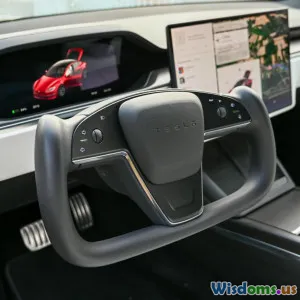
Tracking the Rise of Augmented Reality Windshields in Modern Cars
9 min read Explore how augmented reality windshields are transforming driving with enhanced safety and immersive tech in modern vehicles. (0 Reviews)
Tracking the Rise of Augmented Reality Windshields in Modern Cars
Augmented reality (AR) has permeated numerous facets of technology, from gaming to education. Now, it is making a transformative leap into the automotive sector with augmented reality windshields. Imagine driving with critical data such as speed, navigation, hazard alerts, and even pedestrian positions seamlessly projected onto your windshield, without diverting your eyes from the road. This groundbreaking innovation promises not only to enhance the driving experience but also to significantly improve safety on the roads.
In this article, we dive deep into the emergence of AR windshields, exploring their technology, benefits, adoption, challenges, and the future outlook shaping modern vehicles.
What Are Augmented Reality Windshields?
AR windshields utilize transparent display technology combined with sensors and advanced computing to overlay digital information on the glass through which drivers view the road. Unlike traditional head-up displays (HUDs) that project limited data like speed or navigation onto a small area, AR windshields provide a rich, spatially aware experience, integrating graphics in three-dimensional space aligned with real-world objects.
For example, navigation arrows can be projected directly onto the street, showing precise turns in real-time. Hazard warnings can highlight obstacles, while speed limits and other critical alerts dynamically update without requiring the driver to glance ahead at instrument clusters or phones.
The Technology Behind AR Windshields
Developing AR windshields involves a complex fusion of technologies:
- Transparent Displays: The windshield must function as a display without compromising visibility. Technologies like curved OLED panels, laser projectors embedded in the dashboard, or electrochromic layers are often involved.
- Augmented Reality Software: Using AI-driven data processing to analyze onboard sensor inputs such as cameras, radar, and lidar for object recognition, environmental mapping, and real-time information rendering.
- GPS and Navigation Systems: High precision GPS combined with detailed map data enables accurate AR overlays directly on the road surface.
- Connectivity: Integration with vehicle-to-vehicle (V2V) and vehicle-to-infrastructure (V2I) networks allows dynamic updates, traffic information, and hazard warnings to be displayed instantly.
A notable example is WayRay, a pioneer in AR windshield tech, providing holographic AR navigation displays adaptable to different car models. Their system projects realistic, high-contrast visuals directly onto the windshield, customizable by drivers.
Advantages of AR Windshields in Modern Vehicles
Enhanced Safety
According to a 2020 study by the National Highway Traffic Safety Administration (NHTSA), driver distraction contributes to nearly 9% of fatal crashes. AR windshields help mitigate this by reducing the need for drivers to look away from the road, presenting essential information within the driver’s natural line of sight.
By visually flagging hazards or lane departures, AR systems can improve reaction times. For instance, Volkswagen’s AR heads-up display, available in the ID.3 electric car, illuminates arrows and highlights the correct road paths, greatly assisting navigation and alertness.
Improved Navigation and Driver Assistance
Traditional screen-based GPS systems can be difficult to interpret at high speeds or complicated intersections. AR overlay simplifies navigation by highlighting exact lanes, upcoming turns, and street signs directly in the driver’s field of vision. This improves confidence and reduces mistakes.
Additionally, features like night vision support, that highlight pedestrians or animals invisible to the naked eye under poor lighting, are becoming feasible through AR windshields.
Future-Proofing Vehicles
As autonomous driving evolves, AR windshields provide a versatile human-machine interface, helping drivers understand vehicle decisions and take control if needed. Instead of opaque dashboards, AR empowers an immersive, interactive experience that can adapt via software updates.
Real-World Integration and Industry Adoption
Several automakers and technology companies are already rolling out AR windshield features. Audi introduced an AR navigation HUD in its e-tron models, projecting directional arrows within the driver’s view and marking points of interest around the vehicle.
Hyundai partnered with WayRay to develop AR-equipped versions of their popular Sonata, targeting integration in the early 2020s.
Data from Allied Market Research predicts the global AR automotive market will reach $4.8 billion by 2030, driven strongly by developments in windshield displays.
Challenges and Limitations
Despite tremendous promise, AR windshields face hurdles:
- Cost: Integrating transparent displays and powerful computing hardware increases production costs, raising vehicle prices.
- Technical Complexity: Ensuring precise alignment of AR content under varied lighting and weather does not obstruct the driver's vision is a complex engineering challenge.
- Regulatory Hurdles: Safety standards and regulations for display luminance and distraction levels are still evolving. Authorities need to certify these new systems.
- User Adaptation: Drivers must learn to trust and effectively interpret overlaid virtual cues, which represents a behavioral shift.
Overcoming these issues will require coordinated efforts from automakers, tech firms, regulators, and consumers.
The Road Ahead: Future Trends in AR Windshields
The future will likely see integration with even more sophisticated systems:
- Artificial Intelligence: Personalized AR content adjusting dynamically depending on driver behavior and traffic conditions.
- 5G Connectivity: Real-time cloud data and V2X communication to increase accuracy and responsiveness of AR overlays.
- Expanded Content Types: Beyond navigation, invitations, alerts from social apps, or even in-car entertainment could be embedded into AR windshields.
Tesla CEO Elon Musk has hinted at increasing AR elements in upcoming Teslas, setting a precedent for widespread adoption among electric and autonomous vehicle makers.
Conclusion
Augmented reality windshields represent one of the most exciting innovations in automotive technology today. By seamlessly merging digital information with the driver’s natural view of the world, AR windshields enhance safety, navigation, and overall driving enjoyment.
While challenges around cost, technical complexity, and regulatory standards remain, the fast pace of development and growing investments indicate this technology will soon become commonplace. Whether navigating busy urban streets or taking scenic highway drives, drivers can look forward to a smarter, safer, and more connected experience.
As automobile makers and tech developers race ahead, keeping an eye on augmented reality windshields is essential for anyone interested in the future of transportation.
Author’s note: If you’re curious about how AR technology in cars is evolving or are considering purchasing a vehicle with AR windshield capabilities, stay tuned for upcoming model releases and real-world reviews to see how this innovation performs in daily driving scenarios.
Rate the Post
User Reviews
Popular Posts





















